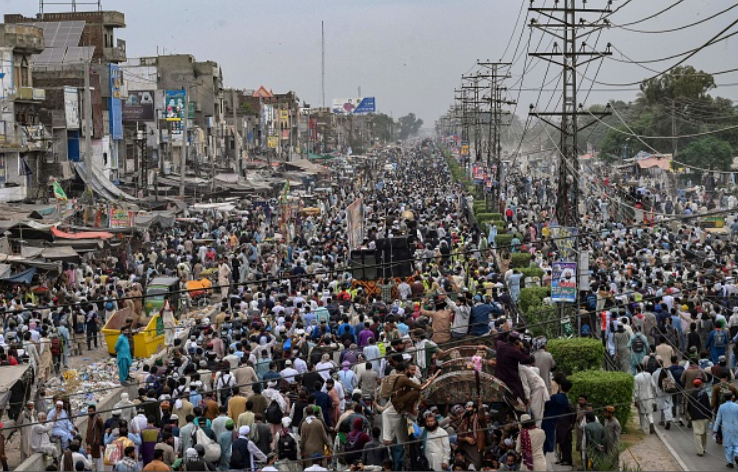
October saw another episode of violent protests in Pakistan, as the government attempted to control the followers of the banned outfit Tehreek-e-Labbaik Pakistan (TLP) while they blocked the main highways of Punjab and marched towards Islamabad, resulting in over 15 deaths. This is not the first time the group has decided to use street power to meet its demands; since its establishment in 2015, the TLP has brought the main cities of Pakistan to a standstill over seven times, each time ending its protests with an “agreement” with the state. Each time, TLP followers were back on the roads in a matter of months as they alleged the government for not following up on the agreed demands. This time, again, the government has reached an agreement, the details of which have not yet been disclosed to the public. And yet again, the government, having no clear long-term policy plan at hand, is bound to face another crisis in the coming months and years. The government is increasingly frustrated at the TLP repeatedly challenging the state’s writ. However, not much will come from this frustration, given the high political costs attached to fundamentally altering policies to curb deep-rooted religious extremism in Pakistan.
The latest round of protests started in November last year, as the group demanded the expulsion of the French ambassador over the French President’s support of the blasphemous caricatures. As the government agreed to fulfill the demand through parliamentary means, the TLP called off the protest only to summon it again in April. Switching from the policy of appeasement to action, the government decided to respond more vehemently by banning the outfit and arresting its leader Saad Rizvi under the anti-terrorism law. But as the protests took a more violent turn, it turned back to the old ad-hoc policy of accepting the group’s demands through negotiated settlement—the resolution to expel the French envoy was presented before the parliament, and a parliamentary committee was established to discuss the matter. As TLP protestors ended sit-ins, the committee did not follow up on the issue. Instead, by extending the detention of TLP head Saad Rizvi, the government misjudged the power of the group as linked to only its leader—not their protesting cadre.
The government is increasingly frustrated at the TLP repeatedly challenging the state’s writ. However, not much will come from this frustration, given the high political costs attached to fundamentally altering policies to curb deep-rooted religious extremism in Pakistan.
Consequently, as TLP followers gathered at its Lahore headquarters on October 19 to celebrate the Prophet’s birthday, they had numerical strength and strong ideological motivations to restart the protest. TLP leadership, accustomed to government strategy of using force alongside negotiation, played their bargaining cards well: initially the protestors chanted for their leader’s release, but as negotiations proceeded, they held that the expulsion of the French ambassador was their “only demand.” As the negotiations reached a deadlock, and government involved clergy to negotiate with them, the TLP denied demaning the French ambassador’s expulsion. Again, the government followed with strong words, such as designating the TLP as a militant group, but took no concrete action, ending the protest with a new settlement expected to expire sooner than later.
While the government is aware of the temporariness of its stop-gap measure, it cannot afford to undertake solution-orientated, long-term policy changes that entail changing the Islamist national identity. The ruling party, Pakistan Tehreek-e-Insaf (PTI), has no ideological ground to disapprove of the TLP demands. It has itself used multilateral forums to voice support for blasphemy laws and criticize global inaction against such acts. Domestically, the party has been trying hard to win credentials among the masses through religious policies and slogans. Hence, the PTI cannot afford to fundamentally challenge a movement built on the same rhetoric. Understandably, it has chosen to question the use of protests against a government that support TLP’s agenda, raising doubts about a possible “foreign hand” behind the group. While such accusations and conspiracies have worked for ethnic parties of the smaller provinces, it is unlikely to work for TLP, who have a strong following in Punjabi urban centers. In the 2018 elections, the party secured over 1.9 million votes—a record-high for any first-timer religious party—of which 80 percent of votes came from Punjab.
Bowing down to the group’s demands—seven times now—has only emboldened TLP’s leadership and cadre. Banning it and detaining its workers has incited more violence.
Additionally, as the PTI had extensively exercised the right of protests in the past, it lacks a convincing discourse to question the method employed by the TLP and linking it with a foreign conspiracy. The challenge before the state is to establish its writ with due regard to the democratic norms. Using force against civilians exercising their right to protest would only give them a moral and political ground to extend their support base. Despite not supporting the radical demands of TLP, the opposition political parties have overtly opposed the use of police action against the protestors. Exploiting the opportunity, the opposition alliance, Pakistan Democratic Movement (PDM), has already started rallying around the country with a different agenda at hand—the growing inflation in the country. The double policy of using force against one while letting other parties protest might have worked if the party in question threatened national interests. However, the TLP’s demands are in sync with the long-build national rhetoric of Islamic identity and leave limited room for exceptional treatment on the grounds of protecting national interests.
The government has no permanent solution to the TLP problem. Bowing down to the group’s demands—seven times now—has only emboldened TLP’s leadership and cadre. Banning it and detaining its workers has incited more violence. The only option that had worked in the past, though temporarily, is negotiated settlement. The government is likely to keep relying on it. Yet, the clock is ticking. The government must develop long-term solutions before the next round of the protest as it is fast losing its credentials among the masses for its poor policies.
***
Image 1: ARIF ALI/AFP via Getty Images


